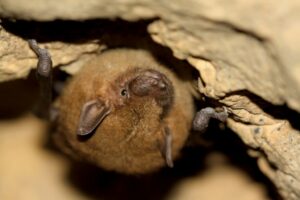By Andrew Berry

This article originally appeared in the fall 2016 issue of our quarterly newsletter, the forest echo.
The silhouette of bats flying against the twilight sky has made impressions on humans for millennia. The history and habits of these flying mammals are steeped in myth and superstition, conjuring a range of feelings from fear to awe. Despite many misconceptions, bats are incredibly important to our ecosystem – a keystone species keeping insects under control and spreading nutrients throughout the forest. But their future is now in doubt due to the spread of the invasive fungus, white – nose syndrome, a pathogen that has spread to nearly every state in the eastern United States.
Bernheim is committed to protecting these vitally critical winged-wonders and promoting greater understanding of our bat species. Our partnerships with the Imperiled Bat Conservation Fund (IBCF) administered by the United States Fish and Wildlife Service, The Kentucky Heritage Land Conservation Fund (KHLCF), and Kentucky Natural Lands Trust (KNLT) are helping protect land and restore habitats within this critical bat conservation range. With white – nose syndrome reducing bat numbers, it is more important than ever to focus on habitat improvements and protecting land that provides forage, roosts, and maternity sites.
Bernheim – A Natural Habitat
During the summer months, bats depend on forests, streams and wetlands, and open grasslands to forage, roost, and raise their pups. Within our more than 14,500 acres of diverse native forest, bats in Bernheim have mature and standing dead trees to roost in, nooks to establish secretive maternity colonies for raising their pups, and habitat for insects that they feed upon at an astounding rate. We have over 74 miles of streams, 56 water bodies, and over 200 acres of grasslands and glades that produce insects for food and open spaces to fly. Many rock outcroppings and caves tucked inside Bernheim provide roosts that we are still learning about and discovering.
Research Guides Conservation Efforts
Bats are incredibly intelligent. Some live in social groups and migrate long distances across the landscape to winter hibernation refuges and summer ranges. They are very skilled at finding food sources and may consume up to their weight in insects every night. They navigate and find insects using echolocation, ultrasonic calls that reverberate off objects and indicate position in space. Bernheim has been monitoring our bat populations by recording these calls, a process referred to as acoustic monitoring. These calls allow for identification of bats to species level. Our research has indicated that we have at least 12 species of bat at Bernheim. There is so much that we are still learning about our bats, and we are trying to establish this baseline information before it is too late.
Indiana bats are some of the most critically endangered bats in Kentucky. Long before white – nose syndrome emerged as a threat, the Indiana bat was in decline due to human disturbance and habitat loss. The species had been documented at Bernheim once, but we remained unsure of how prevalent they were during the summer months. In 2014, with the support of the Imperiled Bat Conservation Fund and Copperhead Consulting, we had artificial bat roosts installed on a restored section of Wilson Creek that provided ideal forage habitat. Our goal was to provide roost habitat and maternity sites for bats during the summer months. In early summer of 2016, a colony of bats including Indiana Bats, with pregnant females, were found to be using the roosts. This was the first maternity site we had located at Bernheim, and these artificial roosts made it possible to confirm their use of Bernheim for rearing pups. Indiana bats typically use dead trees with sloughing bark to stash their pups in groups while out foraging. They stay with the pups during the day and nurse them, then leave them together at night while out feeding, returning at intervals to nurse their young. These artificial roosts perfectly replicate the dead trees that they would use for this process. The confirmation of Indiana bat populations at Bernheim is a tremendous success story in our 87-year history of conservation.
Conservation Thrives Thanks to Partners & Members
Bernheim has added considerable acerage of bat habitat over the past few years with the help of our partners like the IBCF, KNLT and KHLCF. Thanks to these partnerships and the continued support of members and donors, Bernheim is protecting the streams, wetlands, forests, grasslands, glades, caves, and rock outcroppings upon which bats depend. This conservation work gives bats the best chance possible to make it through the white – nose epidemic, the stresses of climate change, and habitat loss. These efforts are critical to ensure a future for bats in the Greater Bernheim Ecosystem, allowing for the next generation of Kentuckians to grow up seeing the silhouette of bats flying against the summer night sky. Our thanks to all of you who make this valuable work possible!
Bat Fun Facts
• Bats are the only flying mammal. Flying squirrels only glide.
• Bats are a very diverse group, with at least 1,240 known species worldwide. That’s 20% of all mammals!
• There are 14 species known from Kentucky. Bernheim has documented 12 species.
• Bats have an evolutionary history dating back at least 52 million years.
• Bats have been documented to live up to 30 years.
• Red bats are the most common bat at Bernheim. Bernheim’s
Documented Bat Species
• Indiana Bat (Myotis sodalis) Federally Endangered
• Gray Bat (Myotis grisescens) Federally Threatened
• Northern Bat (Myotis septentrionalis) Federally Threatened
• Big Brown Bat (Eptesicus fuscus)
• Tricolor Bat (Pipistrellus subflavus)
• Red Bat (Lasiurus borealis)
• Hoary Bat (Lasiurus cinereus)
• Little Brown Bat (Myotis lucifugus)
• Evening Bat (Nycticeius humeralis)
• Rafinesque’s Big-eared Bat (Corynorhinus rafinesquii) Special Concern
• Silver-haired Bat (Lasiurus noctivagans)
• Small-footed Bat(Myotis leibii)

